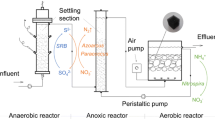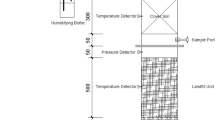Abstract
Hydrogen sulfide (H2S) is one of the major contributors to offensive odors from landfills, and its concentration differs under different operation modes. This study examined the distribution of H2S emission from different landfill depths under different operation modes (anaerobic, semi-aerobic, semi-aerobic transformation, and the three operation modes with additional leachate recirculation). The microbial community (especially the sulfur-metabolizing bacterial community) was investigated using high-throughput sequencing technology. The results showed that the semi-aerobic mode could substantially lower the risks of H2S pollution in landfills, which might be because of the difference in biological processes related to sulfur metabolism driven by functional microbes. A myriad of factors are responsible for mutually shaping the sulfur-metabolizing bacterial community composition in landfills that might subsequently affect the behavior of H2S emission in landfills. The differences in abundance of the genera Acinetobacter and Paracoccus (phylum Proteobacteria) caused by environmental factors might explain the differences in H2S emission. H2S odor control could be realized if the related functional microbe diversity can be influenced by adjustments to landfill operation.




Similar content being viewed by others
References
APHA (1999) Standard methods for the examination of water and wastewater. APHA, Washington, DC
Boetius A, Ravenschlag K, Schubert CJ, Rickert D, Widdel F, Gieseke A, Amann R, Jorgensen BB, Witte U, Pfannkuche O (2000) A marine microbial consortium apparently mediating anaerobic oxidation of methane. Nature 407:623–626
Caldwell SL, Laidler JR, Brewer EA, Eberly JO, Sandborgh SC, Colwell FS (2008) Anaerobic oxidation of methane: mechanisms, bioenergetics, and the ecology of associated microorganisms. Environ Sci Technol 42:6791–6799
Ding Y, Cai CY, Hu B, Xu Y, Zheng XJ, Chen YX, Wu WX (2012) Characterization and control of odorous gases at a landfill site: a case study in Hangzhou, China. Waste Manage 32:317–326
Euzeby JP (1997) List of bacterial names with standing in nomenclature: a folder available on the internet. Int J Syst Bacteriol 47:590–592
Fang CR, Long YY, Lu YY, Shen DS (2009a) Behavior of dimethyl phthalate (DMP) in simulated landfill bioreactors with different operation modes. Int Biodeter Biodegr 63:732–738
Fang CR, Long YY, Shen DS (2009b) Comparison on the removal of phthalic acid diesters in a bioreactor landfill and a conventional landfill. Bioresour Technol 100:5664–5670
Fang Y, Du Y, Feng H, Hu LF, Shen DS, Long YY (2015) Sulfide oxidation and nitrate reduction for potential mitigation of H2S in landfills. Biodegradation 26:115–126
Fierer N, Jackson RB (2006) The diversity and biogeography of soil bacterial communities. Proc Natl Acad Sci USA 103:626–631
Firer D, Friedler E, Lahav O (2008) Control of sulfide in sewer systems by dosage of iron salts: comparison between theoretical and experimental results, and practical implications. Sci Total Environ 392:145–156
Frierich CG, Quentmeier A, Bardischewsky F, Rother D, Orawski G, Hellwig P, Fischer J (2008) Redox control of chemotrophic sulfur oxidation of Paracoccus pantotrophus. In: Dahl C, Frierich CG (eds) Microbial Sulfur Metabolism. Springer, Heidelberg, Berlin, pp 139–150
Hirata O, Matsufuji Y, Tachifuji A, Yanase R (2012) Waste stabilization mechanism by a recirculatory semi-aerobic landfill with the aeration system. J Mater Cycles Waste Manage 14:47–51
Horinouchi M, Kasuga K, Nojiri H, Yamane H, Omori T (1997) Cloning and characterization of genes encoding an enzyme which oxidizes dimethyl sulfide in Acinetobacter sp. strain 20B. FEMS Microbiol Lett 155:99–105
Hornstrom E (2002) Phytoplankton in 63 limed lakes in comparison with the distribution in 500 untreated lakes with varying pH. Hydrobiologia 47:115–126
Kelly DP, Shergill JK, Lu WP, Wood AP (1997) Oxidative metabolism of inorganic sulfur compounds by bacteria. Antonie Van Leeuwenhoek 71:95–107
Kim KH, Choi YJ, Jeon EC, Sunwoo Y (2005) Characterization of malodorous sulfur compounds in landfill gas. Atmos Environ 39:1103–1112
Köchling T, Sanz JL, Gavazza S, Florencio L (2015) Analysis of microbial community structure and composition in leachates from a young landfill by 454 pyrosequencing. Appl Microbiol Biotechnol 99:5657–5668
Li WB, Yao J, Tao PP, Guo MT, Feng XY, He YN, Fang CR, Shen DS (2010) A comparative study on two extraction procedures in speciation of iron in municipal solid waste. J Hazard Mater 182:640–648
Long Y, Guo QW, Fang CR, Zhu YM, Shen DS (2008) In situ nitrogen removal in phase-separate bioreactor landfill. Bioresour Technol 99:5352–5361
Long YY, Hu LF, Fang CR, He R, Shen DS (2009) Releasing behavior of zinc in recirculated bioreactor landfill. Sci Total Environ 407:4110–4116
Long YY, Hu LF, Wang J, Fang CR, He R, Shen DS (2010a) Bio-immobilization of Cu and Zn in recirculated bioreactor landfill. Environ Sci Pollut R 17:1539–1546
Long YY, Shen DS, Wang HT, Lu WJ (2010b) Migration behavior of Cu and Zn in landfill with different operation modes. J Hazard Mater 179:883–890
Lu RK (1999) Agriculture chemical analysis of soil. China Agricultural Scientech Press, Beijing (in Chinese)
Luo JF, Tian GL, Lin WT (2013) Enrichment, isolation and identification of sulfur-oxidizing bacteria from sulfide removing bioreactor. J Environ Sci 25:1393–1399
Mahmood Q, Hu BL, Cai J, Zheng P, Azim MR, Jilani G, Islam E (2009) Isolation of Ochrobactrum sp. QZ2 from sulfide and nitrite treatment system. J Hazard Mater 165:558–565
Masoud W, Takamiya M, Vogensen FK, Lillevang S, Al-Soud WA, Sørensen SJ, Jakobsen M (2011) Characterization of bacterial populations in Danish raw milk cheeses made with different starter cultures by denaturating gradient gel electrophoresis and pyrosequencing. Int Dairy J 21:142–148
Mescia D, Hernández SP, Conoci A, Russo N (2011) MSW landfill biogas desulfurization. Int J Hydrogen Energy 36:7884–7890
Michaelis W, Seifert R, Nauhaus K, Treude T, Thiel V, Blumenberg M, Knittel K, Gieseke A, Peterknecht K, Pape T, Boetius A, Amann R, Jorgensen BB, Widdel F, Peckmann J, Pimenov NV, Gulin MB (2002) Microbial reefs in the Black Sea fueled by anaerobic oxidation of methane. Science 297:1013–1015
Qiu CL, Liu JX, Peng ML (1992) Amendment method for sulfide content of soil. Public Heath 8:549–550
Schauer R, Røy H, Augustin N, Gennerich HH, Peters M, Wenzhoefer F, Amann R, Meyerdierks A (2011) Bacterial sulfur cycling shapes microbial communities in surface sediments of an ultramafic hydrothermal vent field. Environ Microbiol 13:2633–2648
Sener B, Süzen ML, Doyuran V (2006) Landfill site selection by using geographic information systems. Environ Geol 49:376–388
Sorokin DY, Teske A, Robertson LA, Kuenen JG (1999) Anaerobic oxidation of thiosulfate to tetrathionate by obligately heterotrophic bacteria, belonging to the Pseudomonas stutzeri group. FEMS Microbiol Ecol 30:113–123
Zhang JB, Zhang T, Ma K, Chen GH, Zhang DY, Wei XH (2008) Isolation and identification of the thermophilic alkaline desulphuricant strain. Sci China, Ser B 51:158–165
Zhang Y, Zhao ZH, Chen CTA, Tang K, Su JQ, Jiao NZ (2012) Sulfur metabolizing microbes dominate microbial communities in andesite-hosted shallow-sea hydrothermal systems. PLoS One 7:e44593
Zhang XQ, Feng HJ, Liang YX, Zhao ZQ, Long YY, Fang Y, Wang MZ, Yin J, Shen DS (2015) The relief of microtherm inhibition for p-fluoronitrobenzene mineralization using electrical stimulation at low temperatures. Appl Microbiol Biotechnol 99(10):4485–4494
Acknowledgments
This work was financially supported by the National Natural Science Foundation of China (41471408 and 41101453) and the Natural Science Foundation of Zhejiang Province (LY14D010001).
Author information
Authors and Affiliations
Corresponding author
Rights and permissions
About this article
Cite this article
Fang, Y., Du, Y., Hu, L. et al. Effects of sulfur-metabolizing bacterial community diversity on H2S emission behavior in landfills with different operation modes. Biodegradation 27, 237–246 (2016). https://doi.org/10.1007/s10532-016-9769-2
Received:
Accepted:
Published:
Issue Date:
DOI: https://doi.org/10.1007/s10532-016-9769-2




